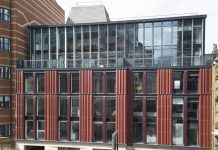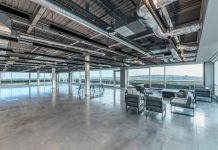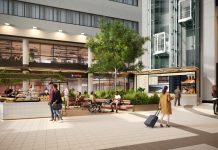By Eamon Fox, partner and head of office agency at the Leeds office of global property consultancy Knight Frank:
COVID-19 has turned the world upside down and, as much as we all want to return to normal, significant aspects of business and the office will change – forever. In the short-term, we are sheltering at home, many working in unusual surroundings. In the longer term, most of us will return to an office that will be markedly different from the one we knew before this deadly virus struck.
A recent survey, conducted by ICM, revealed that almost half of workers questioned believed that they would spend less time in the office as a result of Covid-19. They predicted a permanent change in their employers’ approach to flexible working when the lockdown eventually lifts. A third expected to increase the amount of time they work from home to at least three days a week.
Clearly the genie is out of the bottle when it comes to working from home. It is not a passport to binging on fast food and box sets, only responding to emails when absolutely necessary. Rather, it is now a crucial part of the fabric of our working lives. Inevitably this presents challenges for those who are going to develop, design, occupy and market the post-Covid-19 office.
The World Health Organisation (WHO) is already giving clear advice about best practice for the re-occupancy of offices. This advice should provide a blueprint for both the design and the culture of the mid-21st century office. First of all, it is critical to build trust and confidence with staff to ensure that they feel safe to return. Without that confidence, any change to the office environment is doomed to failure. Nobody is able to work effectively if they feel unsafe or worried.
There are specific ways in which to increase the safety of staff. Enclosed spaces can be used as individual workplaces, eg small offices, small meeting rooms and phone booths. Open spaces must have workstations that are 2m apart – and clearly marked as single occupancy.
Hot desking is out. Larger meeting rooms must be treated with great caution; each room must be evaluated, using the 2m separation yardstick to determine maximum capacity. The same rules apply to office cafes, microwaves and water points. Reception areas will have to be remodelled to ensure queues and close personal contact are avoided, while receptionists themselves should be behind screens. All this isn’t going to be easy, as office occupation has become denser during the past 10 years, as we explain in Knight Frank’s new report Roadmap For Re-occupancy.
It is also very important to develop an office occupancy strategy, matching capacity with demand, by creating distinct teams and rotating them between working in the office and working from home, ideally between two to three days a week. It is vital, though, to avoid creating a working from home culture, as this negates many advantages of office working, such as collaboration, inspiration, innovation, friendship and a sense of a shared direction.
It also goes without saying that the cleaning of every single area of every single office must be forensic, while state-of-the-art air-conditioning to improve dilution and removal of contaminants is essential. Waste and recycling will need close attention. Particular care must be taken with potentially contaminated waste streams (face masks, gloves, cleaning materials, etc.). Obviously, system maintenance and cleaning regimes should be regular and scrupulous.
All this presents huge challenges for office designers and occupiers alike. Recent research, for example, has suggested that 60 per cent of the UK’s 11.8 million desks would be unusable if a 2m gap was introduced. And the challenges don’t just apply to how we use existing office space; developers working on new-build offices need to rethink their plans. If the open plan office is dead, what is going to replace it? Should cubicles make a return? Are co-working and flexible space now obsolete?
But with challenges come opportunities, especially for regions like Yorkshire. There is every likelihood that many large firms, keen to avoid having too many staff in one single building, will look to diversify their operations geographically. This “flight to localism” and reversal of centralisation could have a big impact of cities like Leeds, which already have the infrastructure, the reputation and the culture to enable big London corporations to flourish. The decision of Channel 4 to relocate to the magnificent Majestic building in the heart of the city is a resounding endorsement of what Leeds has to offer.
The city already has occupier-ready buildings, too, which have tackled the challenges of the modern office. Take 34 Boar Lane, for example, arguably the most dynamic mixed-use destinations in Leeds. Formerly CGU House, and located immediately opposite the railway station and Trinity Leeds shopping centre, the 56,000 sq ft building has been transformed into diverse community of like-minded people shaping a place together, with connected environments – digitally, physically, socially, but within a design-led, tech-savvy quality space for occupiers to work safely within.
Inspirational buildings such as 34 Boar Lane, Platform, One City Square and the Majestic, together with proposed developments such as CEG’s Temple on the city’s South Bank, point the way to a bright post-Covid 19 future. The modern office must change – but there is every indication that developers and occupiers, working together, can create a new office environment where everyone can work safely and productively together.
Let the last word go to David Bailey of leading Leeds-based architects DLG, responsible for inspiring buildings like Platform and 33 Wellington Street, who says: “Looking ahead in the long-term, when the pandemic goes away, we’ll be able to dismantle the impersonal plastic screens, return to sharing lifts, enjoy a chat in kitchen whilst making a brew and get back to picking up some of the real positives from the office model that we’ve all spent years honing.
“We’re all inherently social creatures that thrive on being with one another, eye to eye and face to face contact will be possible again bringing back all the positives we’ve all enjoyed in Co-working, the sort of interactions that give so many organisations their unique spark. We need to be careful that what we design now isn’t a knee jerk reaction to the current situation but suits our clients’ requirements beyond Covid-19.”






















